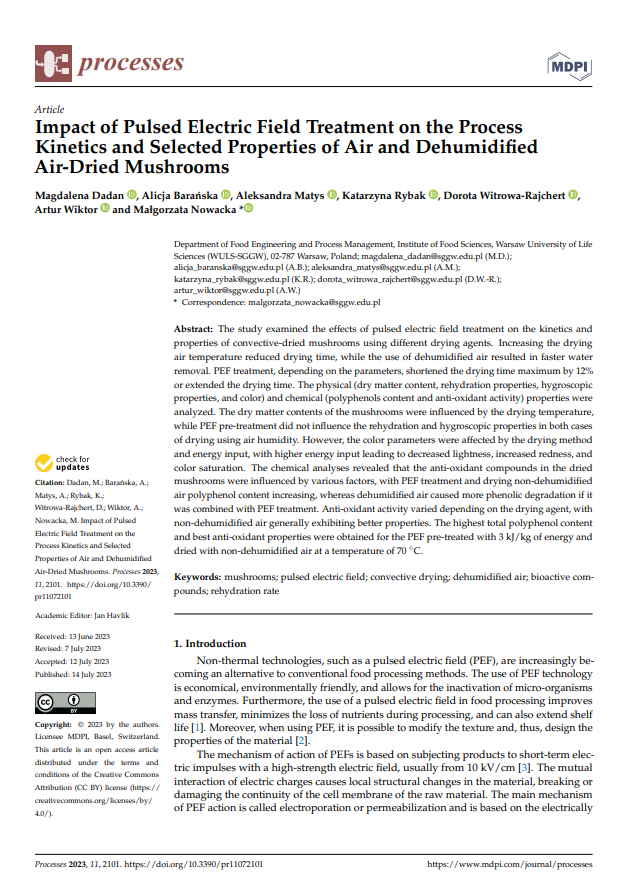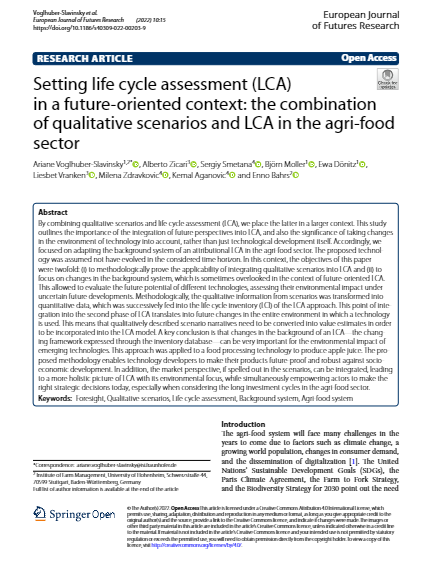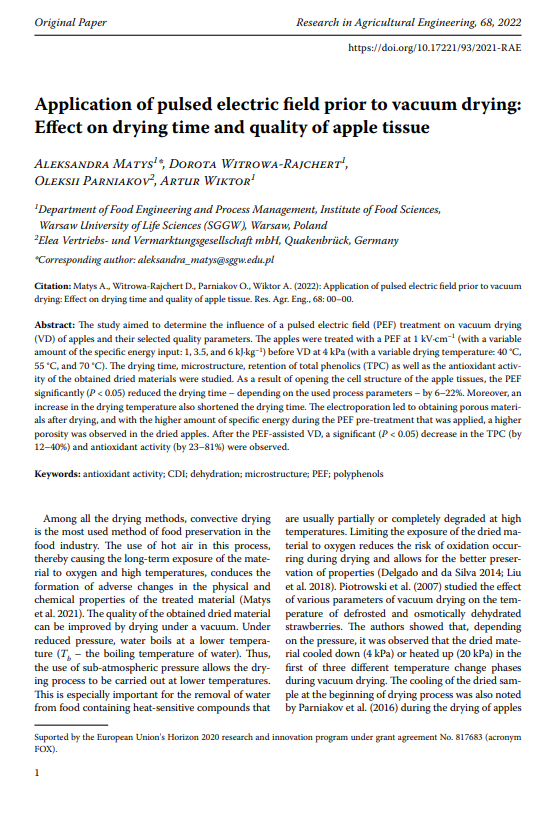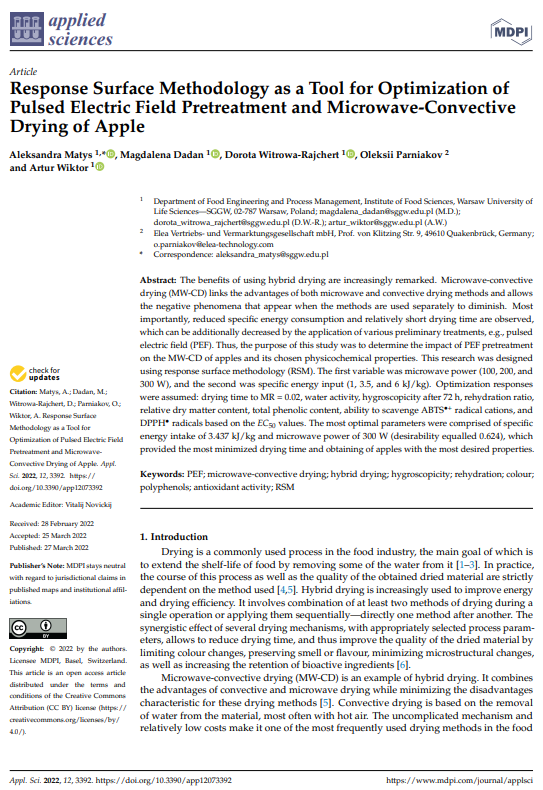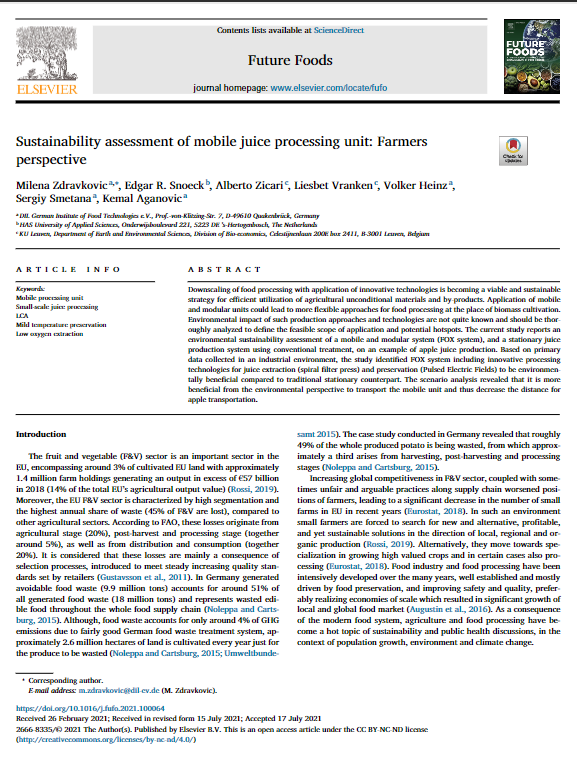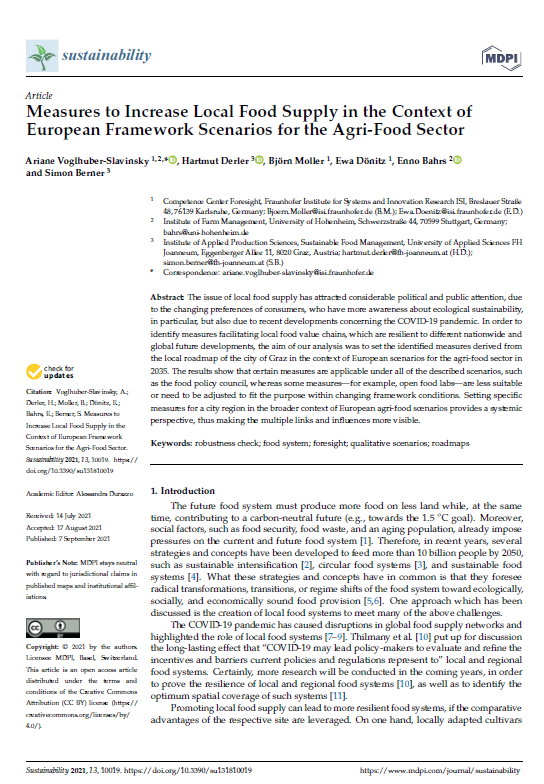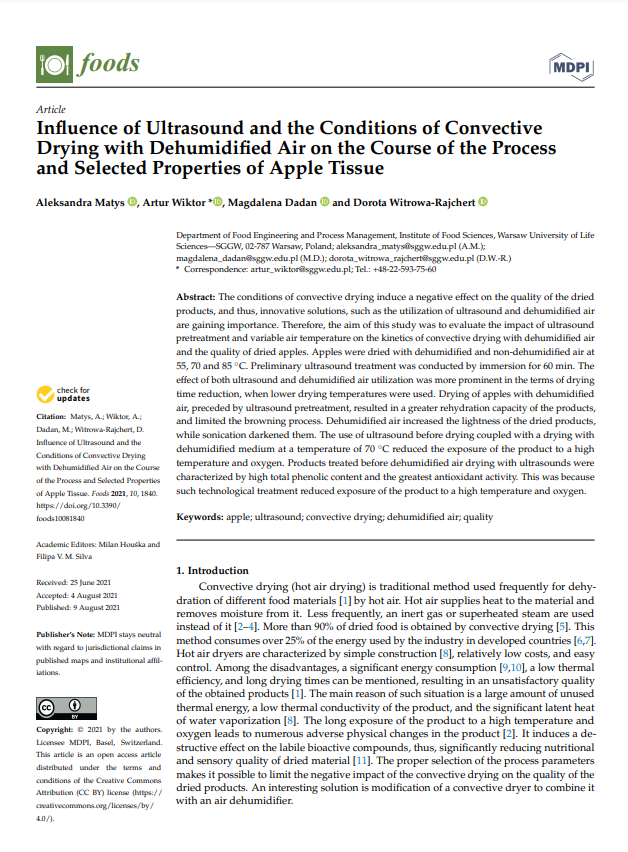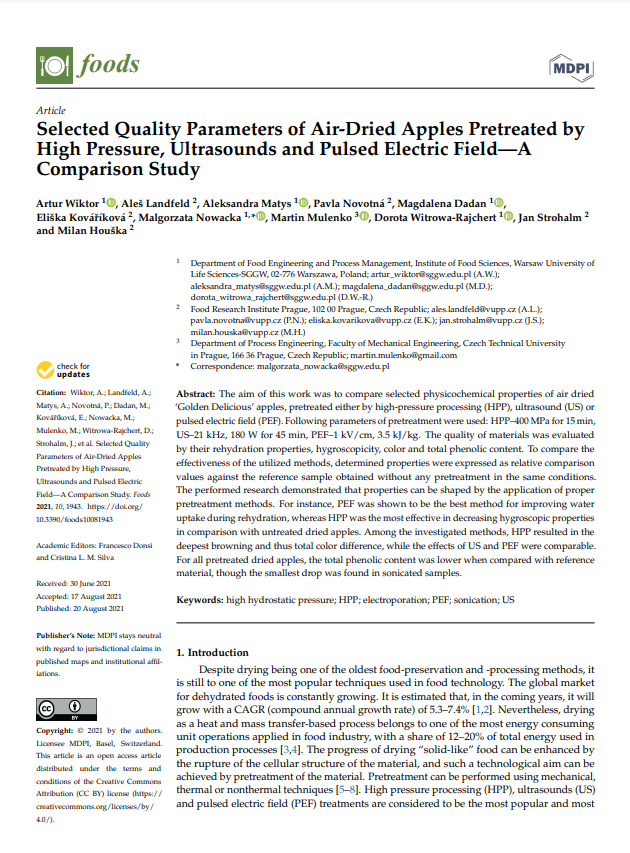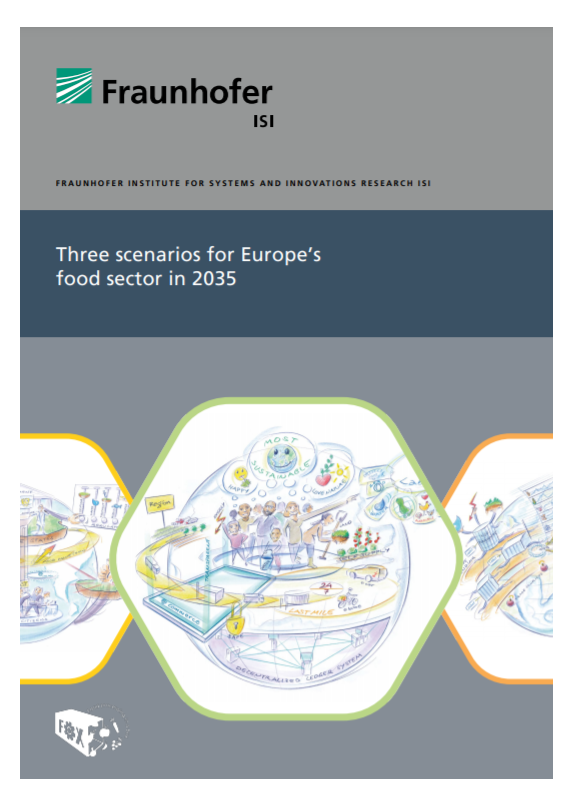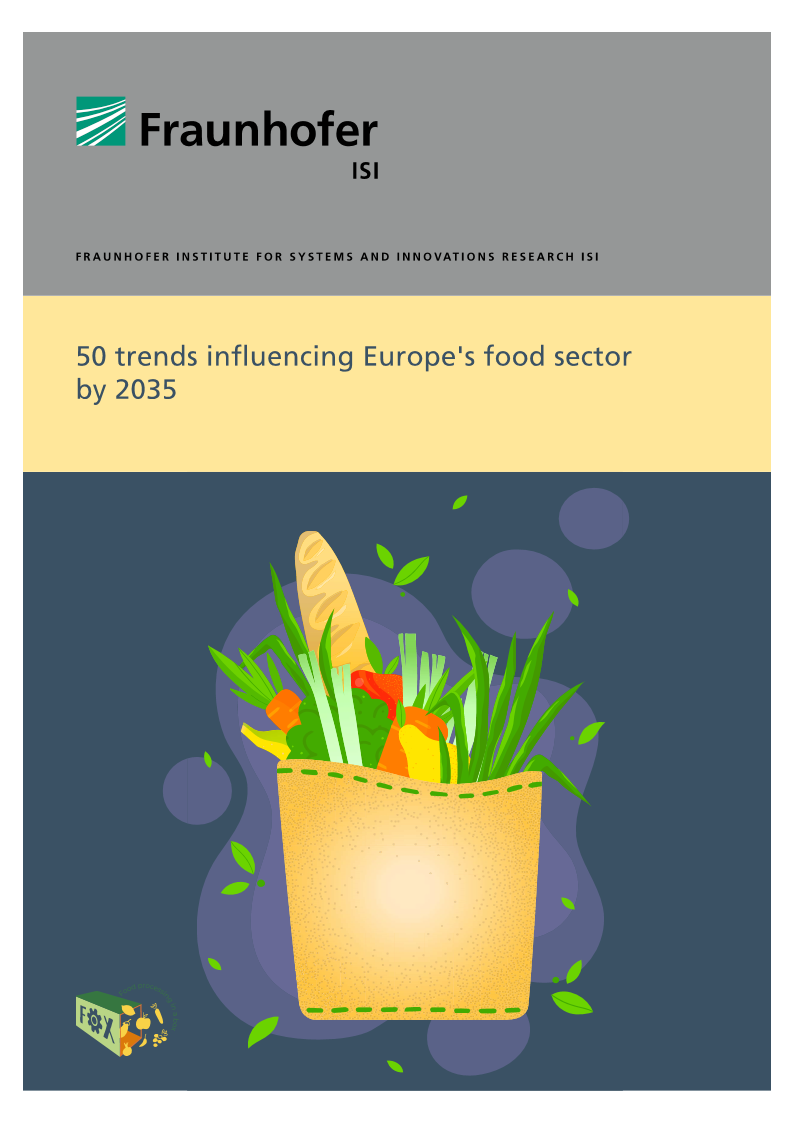Article: Impact of Pulsed Electric Field Treatment on the Process Kinetics and Selected Properties of Air and Dehumidified Air-Dried Mushrooms (July 2023)
The study examined the effects of pulsed electric field treatment on the kinetics and properties of convective-dried mushrooms using different drying agents. Increasing the drying air temperature reduced drying time, while the use of dehumidified air resulted in faster water removal. PEF treatment, depending on the parameters, shortened the drying time maximum by 12% or extended the drying time. The physical (dry matter content, rehydration properties, hygroscopic properties, and color) and chemical (polyphenols content and anti-oxidant activity) properties were analyzed. The dry matter contents of the mushrooms were influenced by the drying temperature, while PEF pre-treatment did not influence the rehydration and hygroscopic properties in both cases of drying using air humidity. However, the color parameters were affected by the drying method and energy input, with higher energy input leading to decreased lightness, increased redness, and color saturation. The chemical analyses revealed that the anti-oxidant compounds in the dried mushrooms were influenced by various factors, with PEF treatment and drying non-dehumidified air polyphenol content increasing, whereas dehumidified air caused more phenolic degradation if it was combined with PEF treatment. Anti-oxidant activity varied depending on the drying agent, with non-dehumidified air generally exhibiting better properties. The highest total polyphenol content and best anti-oxidant properties were obtained for the PEF pre-treated with 3 kJ/kg of energy and dried with non-dehumidified air at a temperature of 70°C.
Article: Setting life cycle assessment (LCA) in a future‑oriented context: the combination of qualitative scenarios and LCA in the agri‑food sector (Jun. 2022)
By combining qualitative scenarios and life cycle assessment (LCA), we place the latter in a larger context. This study outlines the importance of the integration of future perspectives into LCA, and also the significance of taking changes in the environment of technology into account, rather than just technological development itself. Accordingly, we focused on adapting the background system of an attributional LCA in the agri‑food sector. The proposed technology was assumed not have evolved in the considered time horizon. In this context, the objectives of this paper were twofold: (i) to methodologically prove the applicability of integrating qualitative scenarios into LCA and (ii) to focus on changes in the background system, which is sometimes overlooked in the context of future‑oriented LCA. This allowed to evaluate the future potential of different technologies, assessing their environmental impact under uncertain future developments. Methodologically, the qualitative information from scenarios was transformed into quantitative data, which was successively fed into the life cycle inventory (LCI) of the LCA approach. This point of integration into the second phase of LCA translates into future changes in the entire environment in which a technology is used. This means that qualitatively described scenario narratives need to be converted into value estimates in order to be incorporated into the LCA model. A key conclusion is that changes in the background of an LCA—the changing framework expressed through the inventory database—can be very important for the environmental impact of emerging technologies. This approach was applied to a food processing technology to produce apple juice. The pro‑ posed methodology enables technology developers to make their products future‑proof and robust against socio‑economic development. In addition, the market perspective, if spelled out in the scenarios, can be integrated, leading to a more holistic picture of LCA with its environmental focus, while simultaneously empowering actors to make the right strategic decisions today, especially when considering the long investment cycles in the agri‑food sector.
Article: Application of pulsed electric field prior to vacuum drying: Effect on drying time and quality of apple tissue (Jun. 2022)
The study aimed to determine the influence of a pulsed electric field (PEF) treatment on vacuum drying (VD) of apples and their selected quality parameters. The apples were treated with a PEF at 1 kV·cm–1 (with a variable amount of the specific energy input: 1, 3.5, and 6 kJ·kg–1) before VD at 4 kPa (with a variable drying temperature: 40 °C, 55 °C, and 70 °C). The drying time, microstructure, retention of total phenolics (TPC) as well as the antioxidant activity of the obtained dried materials were studied. As a result of opening the cell structure of the apple tissues, the PEF significantly (P < 0.05) reduced the drying time – depending on the used process parameters – by 6–22%. Moreover, an increase in the drying temperature also shortened the drying time. The electroporation led to obtaining porous materials after drying, and with the higher amount of specific energy during the PEF pre-treatment that was applied, a higher porosity was observed in the dried apples. After the PEF-assisted VD, a significant (P < 0.05) decrease in the TPC (by 12–40%) and antioxidant activity (by 23–81%) were observed.
Article: Response Surface Methodology as a Tool for Optimization of Pulsed Electric Field Pretreatment and Microwave-Convective Drying of Apple (Mar. 2022)
The benefits of using hybrid drying are increasingly remarked. Microwave-convective drying (MW-CD) links the advantages of both microwave and convective drying methods and allows the negative phenomena that appear when the methods are used separately to diminish. Most importantly, reduced specific energy consumption and relatively short drying time are observed, which can be additionally decreased by the application of various preliminary treatments, e.g., pulsed electric field (PEF). Thus, the purpose of this study was to determine the impact of PEF pretreatment on the MW-CD of apples and its chosen physicochemical properties. This research was designed using response surface methodology (RSM). The first variable was microwave power (100, 200, and 300 W), and the second was specific energy input (1, 3.5, and 6 kJ/kg). Optimization responses were assumed: drying time to MR = 0.02, water activity, hygroscopicity after 72 h, rehydration ratio, relative dry matter content, total phenolic content, ability to scavenge ABTS•+ radical cations, and DPPH• radicals based on the EC50 values. The most optimal parameters were comprised of specific energy intake of 3.437 kJ/kg and microwave power of 300 W (desirability equalled 0.624), which provided the most minimized drying time and obtaining of apples with the most desired properties.
Article: Sustainability assessment of mobile juice processing unit: Farmers perspective (Dec. 2021)
Downscaling of food processing with application of innovative technologies is becoming a viable and sustainable strategy for efficient utilization of agricultural unconditional materials and by-products. Application of mobile and modular units could lead to more flexible approaches for food processing at the place of biomass cultivation. Environmental impact of such production approaches and technologies are not quite known and should be thoroughly analyzed to define the feasible scope of application and potential hotspots. The current study reports an environmental sustainability assessment of a mobile and modular system (FOX system), and a stationary juice production system using conventional treatment, on an example of apple juice production. Based on primary data collected in an industrial environment, the study identified FOX system including innovative processing technologies for juice extraction (spiral filter press) and preservation (Pulsed Electric Fields) to be environmentally beneficial compared to traditional stationary counterpart. The scenario analysis revealed that it is more beneficial from the environmental perspective to transport the mobile unit and thus decrease the distance for apple transportation.
Article: Measures to Increase Local Food Supply in the Context of European Framework Scenarios for the Agri-Food Sector (Sept. 2021)
The issue of local food supply has attracted considerable political and public attention, due to the changing preferences of consumers, who have more awareness about ecological sustainability, in particular, but also due to recent developments concerning the COVID-19 pandemic. In order to identify measures facilitating local food value chains, which are resilient to different nationwide and global future developments, the aim of our analysis was to set the identified measures derived from the local roadmap of the city of Graz in the context of European scenarios for the agri-food sector in 2035. The results show that certain measures are applicable under all of the described scenarios, such as the food policy council, whereas some measures—for example, open food labs—are less suitable or need to be adjusted to fit the purpose within changing framework conditions. Setting specific measures for a city region in the broader context of European agri-food scenarios provides a systemic perspective, thus making the multiple links and influences more visible.
Article: Influence of Ultrasound and the Conditions of Convective Drying with Dehumidified Air on the Course of the Process and Selected Properties of Apple Tissue (Aug. 2021)
The conditions of convective drying induce a negative effect on the quality of the dried products, and thus, innovative solutions, such as the utilization of ultrasound and dehumidified air are gaining importance. Therefore, the aim of this study was to evaluate the impact of ultrasound pretreatment and variable air temperature on the kinetics of convective drying with dehumidified air and the quality of dried apples. Apples were dried with dehumidified and non-dehumidified air at 55, 70 and 85 °C. Preliminary ultrasound treatment was conducted by immersion for 60 min. The effect of both ultrasound and dehumidified air utilization was more prominent in the terms of drying time reduction, when lower drying temperatures were used. Drying of apples with dehumidified air, preceded by ultrasound pretreatment, resulted in a greater rehydration capacity of the products, and limited the browning process. Dehumidified air increased the lightness of the dried products, while sonication darkened them. The use of ultrasound before drying coupled with a drying with dehumidified medium at a temperature of 70 °C reduced the exposure of the product to a high temperature and oxygen. Products treated before dehumidified air drying with ultrasounds were characterized by high total phenolic content and the greatest antioxidant activity. This was because such technological treatment reduced exposure of the product to a high temperature and oxygen
Article: Selected Quality Parameters of Air-Dried Apples Pretreated by High Pressure, Ultrasounds and Pulsed Electric Field—A Comparison Study (Aug. 2021)
The aim of this work was to compare selected physicochemical properties of air dried ‘Golden Delicious’ apples, pretreated either by high-pressure processing (HPP), ultrasound (US) or pulsed electric field (PEF). Following parameters of pretreatment were used: HPP–400 MPa for 15 min, US–21 kHz, 180 W for 45 min, PEF–1 kV/cm, 3.5 kJ/kg. The quality of materials was evaluated by their rehydration properties, hygroscopicity, color and total phenolic content. To compare the effectiveness of the utilized methods, determined properties were expressed as relative comparison values against the reference sample obtained without any pretreatment in the same conditions. The performed research demonstrated that properties can be shaped by the application of proper pretreatment methods. For instance, PEF was shown to be the best method for improving water uptake during rehydration, whereas HPP was the most effective in decreasing hygroscopic properties in comparison with untreated dried apples. Among the investigated methods, HPP resulted in the deepest browning and thus total color difference, while the effects of US and PEF were comparable. For all pretreated dried apples, the total phenolic content was lower when compared with reference material, though the smallest drop was found in sonicated samples
Research Reports
Brochure: Three scenarios for Europe’s food sector in 2035 (2020)
Vertical farming and urban gardening, artificial intelligence in food retail, burgers made from insects as alternative proteins, or online grocery shopping – many social trends and technologies are influencing the food system today and will shape how the European food sector will look like in 2035. These trends are already apparent today, but which of them could change the whole food system on the long term? Which trends are only hypes and temporary? These and many other questions are part of the EU Horizon 2020 project FOX, and are at the core of FOX’s foresight research component.
Taking the “50 trends influencing Europe’s food sector by 2035” as a starting point, an online foresight scenario process was designed and conducted to draw three alternative pictures of the future, how the European food sector could look like in 15 years. The aim is not to predict exactly how the food sector will develop because this is impossible. However, the aim is to contribute to the discussion by reflecting and studying possible influencing aspects and alternative futures, as a look into the future creates the possibility to develop together ideas for improvement strategies to be better prepared.
Brochure: 50 trends influencing Europe’s food sector by 2035 (2019)
Europe 2035 – What are we going to eat? Where will we do our grocery shopping? How can we produce food using fewer resources? Who can benefit most from new trends? Which other industries will affect the food industry? What will the food sector look like? These questions are part of the EU Horizon 2020 project FOX, and are at the core of FOX’s foresight research component.
The Competence Center Foresight of the Fraunhofer Institute for Systems and Innovation Research ISI derives and conducts foresight processes for developing future scenarios that outline the framework conditions of the European food innovation system of 2035.
As part of this process, scientists and experts have identified and analyzed a variety of trends influencing the food sector. The most compelling 50 are presented as “trends to go” in this brochure. With additional information, the 15 most relevant trends are explained in more detail as “trends à la carte”.

